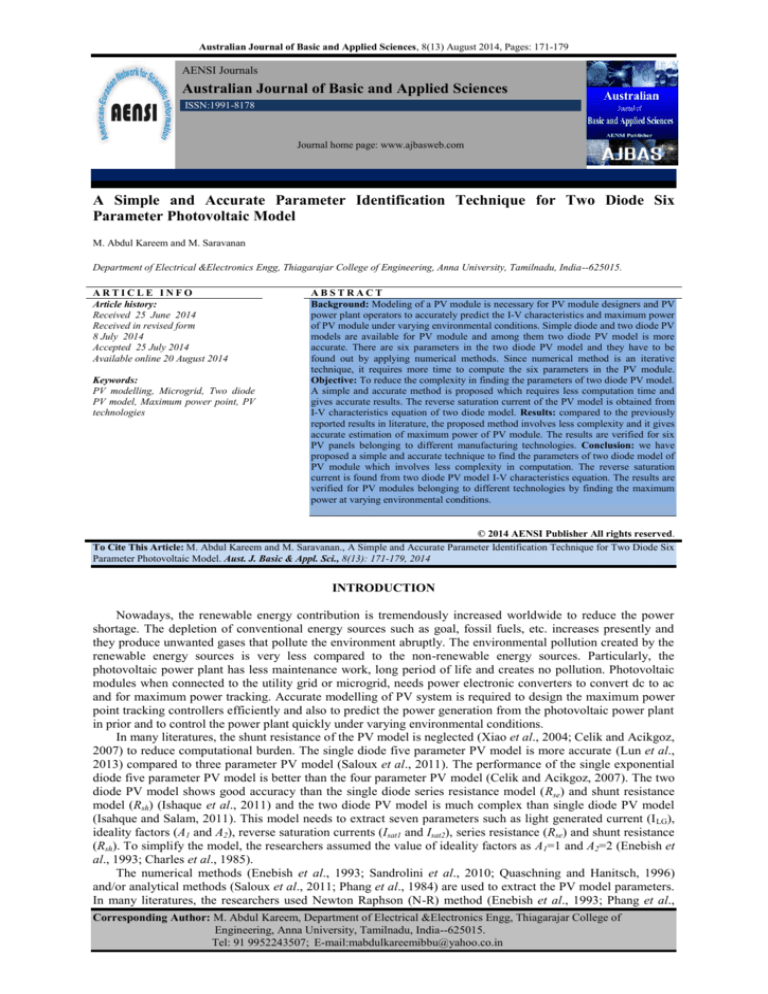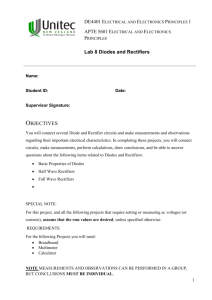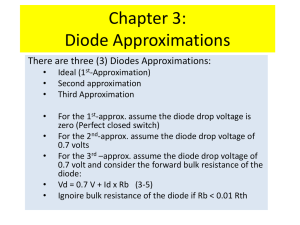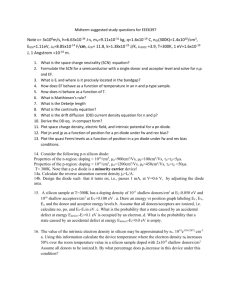
Australian Journal of Basic and Applied Sciences, 8(13) August 2014, Pages: 171-179
AENSI Journals
Australian Journal of Basic and Applied Sciences
ISSN:1991-8178
Journal home page: www.ajbasweb.com
A Simple and Accurate Parameter Identification Technique for Two Diode Six
Parameter Photovoltaic Model
M. Abdul Kareem and M. Saravanan
Department of Electrical &Electronics Engg, Thiagarajar College of Engineering, Anna University, Tamilnadu, India--625015.
ARTICLE INFO
Article history:
Received 25 June 2014
Received in revised form
8 July 2014
Accepted 25 July 2014
Available online 20 August 2014
Keywords:
PV modelling, Microgrid, Two diode
PV model, Maximum power point, PV
technologies
ABSTRACT
Background: Modeling of a PV module is necessary for PV module designers and PV
power plant operators to accurately predict the I-V characteristics and maximum power
of PV module under varying environmental conditions. Simple diode and two diode PV
models are available for PV module and among them two diode PV model is more
accurate. There are six parameters in the two diode PV model and they have to be
found out by applying numerical methods. Since numerical method is an iterative
technique, it requires more time to compute the six parameters in the PV module.
Objective: To reduce the complexity in finding the parameters of two diode PV model.
A simple and accurate method is proposed which requires less computation time and
gives accurate results. The reverse saturation current of the PV model is obtained from
I-V characteristics equation of two diode model. Results: compared to the previously
reported results in literature, the proposed method involves less complexity and it gives
accurate estimation of maximum power of PV module. The results are verified for six
PV panels belonging to different manufacturing technologies. Conclusion: we have
proposed a simple and accurate technique to find the parameters of two diode model of
PV module which involves less complexity in computation. The reverse saturation
current is found from two diode PV model I-V characteristics equation. The results are
verified for PV modules belonging to different technologies by finding the maximum
power at varying environmental conditions.
© 2014 AENSI Publisher All rights reserved.
To Cite This Article: M. Abdul Kareem and M. Saravanan., A Simple and Accurate Parameter Identification Technique for Two Diode Six
Parameter Photovoltaic Model. Aust. J. Basic & Appl. Sci., 8(13): 171-179, 2014
INTRODUCTION
Nowadays, the renewable energy contribution is tremendously increased worldwide to reduce the power
shortage. The depletion of conventional energy sources such as goal, fossil fuels, etc. increases presently and
they produce unwanted gases that pollute the environment abruptly. The environmental pollution created by the
renewable energy sources is very less compared to the non-renewable energy sources. Particularly, the
photovoltaic power plant has less maintenance work, long period of life and creates no pollution. Photovoltaic
modules when connected to the utility grid or microgrid, needs power electronic converters to convert dc to ac
and for maximum power tracking. Accurate modelling of PV system is required to design the maximum power
point tracking controllers efficiently and also to predict the power generation from the photovoltaic power plant
in prior and to control the power plant quickly under varying environmental conditions.
In many literatures, the shunt resistance of the PV model is neglected (Xiao et al., 2004; Celik and Acikgoz,
2007) to reduce computational burden. The single diode five parameter PV model is more accurate (Lun et al.,
2013) compared to three parameter PV model (Saloux et al., 2011). The performance of the single exponential
diode five parameter PV model is better than the four parameter PV model (Celik and Acikgoz, 2007). The two
diode PV model shows good accuracy than the single diode series resistance model (Rse) and shunt resistance
model (Rsh) (Ishaque et al., 2011) and the two diode PV model is much complex than single diode PV model
(Isahque and Salam, 2011). This model needs to extract seven parameters such as light generated current (I LG),
ideality factors (A1 and A2), reverse saturation currents (Isat1 and Isat2), series resistance (Rse) and shunt resistance
(Rsh). To simplify the model, the researchers assumed the value of ideality factors as A1=1 and A2=2 (Enebish et
al., 1993; Charles et al., 1985).
The numerical methods (Enebish et al., 1993; Sandrolini et al., 2010; Quaschning and Hanitsch, 1996)
and/or analytical methods (Saloux et al., 2011; Phang et al., 1984) are used to extract the PV model parameters.
In many literatures, the researchers used Newton Raphson (N-R) method (Enebish et al., 1993; Phang et al.,
Corresponding Author: M. Abdul Kareem, Department of Electrical &Electronics Engg, Thiagarajar College of
Engineering, Anna University, Tamilnadu, India--625015.
Tel: 91 9952243507; E-mail:mabdulkareemibbu@yahoo.co.in
172
M. Abdul Kareem and M. Saravanan, 2014
Australian Journal of Basic and Applied Sciences, 8(13) August 2014, Pages: 171-179
1984; Zhu et al., 2011) for evaluating the PV model parameters. In two diode PV model, the researchers used
the expression for finding the value of reverse saturation current from single diode four parameter (Ishaque et
al., 2011) PV model or single diode five parameter (Kishor et al., 2010) of the PV model. In this paper, two
diode six parameter PV model is proposed. The expression for the reverse saturation current (Isat) is obtained
from the two diode PV model’s I – V characteristics equation. In the proposed model, the shunt resistance (Rsh)
is neglected for simplifying the model and it gives more accurate results when compared to single diode model.
Newton Raphson method is used to estimate the value of series resistance (Rs) from implicit equation. The
proposed model is useful for PV module designers and photovoltaic power plant controllers.
Modelling of solar Photovoltaic module:
a. Two diode seven parameter PV model:
The two diode PV model is shown in Figure 1. The current – voltage characteristics equation of this model
is given by
V IR
V IR
(
)
(
)
V IRse
(1)
I I I [e A V 1] I [e A V 1]
se
se
1 t
LG
2 t
sat1
sat 2
where
Isat1, Isat2
A1, A2
Rsh
- Reverse saturation currents of the diode 1 and diode 2
- ideality factors of the diffusion current diode and recombination current diode
Vt1 Vt 2 Vt
N s kT
q
Where Vt1, Vt2
(2)
- thermal voltage of the diode 1 and diode 2
Fig. 1: Two diode seven parameter model of PV module.
To accurately estimate the PV module I – V characteristics curve of the two diode PV model, the
parameters such as light generated current (ILG), reverse saturation currents (Isat1 and Isat2), ideality factors (A1
and A2), series resistance (Rs) and shunt resistance (Rsh) are found out.The accuracy of the two diode PV model
is high when compared to that of single diode PV model. In many literatures, the researchers assumes the value
of ideality factors A1=1 and A2=2 (Enebish et al.,1993; Charles et al., 1985).
b. Two diode six parameter PV model:
In a two diode six parameter PV model, the shunt resistance value is considered as infinity. Due to the high
value of shunt resistance, the leakage current through the shunt resistance is negligible. The effect of PV
module’s shunt resistance is insensitive under varying environmental conditions. This assumption reduces the
complexity of the PV model and also the computational time. The two diode six parameter PV model is shown
in Figure 2 and its I – V characteristics equation is described as follows:
I I LG I sat1[e
(
V IRse
)
A1Vt
1] I sat 2 [e
(
V IRse
)
A2Vt
1]
Fig. 2: Two diode six parameter model of PV module.
Parameter extraction of two diode PV model:
In a two diode six parameter PV model, the following assumptions are considered.
1. The reverse saturation current of diode 1 and diode are equal (Isat1= Isat2=Isat).
2. The value of ideality factors of diode 1 and diode 2 are taken as A1=1 and A2=2.
(3)
173
M. Abdul Kareem and M. Saravanan, 2014
Australian Journal of Basic and Applied Sciences, 8(13) August 2014, Pages: 171-179
By applying short circuit condition in equation (3), the following equation (4) can be obtained in terms of
reverse saturation current.
(4)
I LG
I sat1 I sat 2 I sat
Voc
Voc
e A1Vt e A2Vt 2
The light generated current directly depends on varying temperature and irradiation condition. According to
the variation of irradiation and temperature, the light generated current can be expressed by equation (5).
G
(5)
I (I
k (T T ))
LG
LG ( stc )
i
c
stc
G stc
Where Gstc
– Irradiance at STC (W/m2)
G – Irradiance under given operating condition (W/m2)
ILG_GT
– Light generated current under varying environmental conditions
ki - Temperature coefficient of short circuit current (mA/ºC)
Tstc - Temperature at STC (°K)
The open circuit voltage decreases when the temperature of PV module increases. The open circuit voltage
does not directly depend on irradiation. Under varying temperature and irradiation conditions, the open circuit
voltage can be expressed as in the equation (6).
( A A2 )
G
(6)
V V
1
V ln(
) K (T T )
oc
oc ( stc )
Where
t
S
Gstc
,The
( A1 A2 )
1
S
v
c
stc
PV module’s reverse saturation current depends on variation of temperature and the
irradiation variation does not affect the reverse saturation current of the PV module. Equations (5) and (6) are
inserted into equation (4) and the equation (7) is obtained.
G
(7)
( I LG ( stc ) k i (Tc Tstc ))
G
I sat1 I sat 2 I sat
Voc ( stc )
e
( A1 A2 )
S
Vt ln(
Voc ( stc )
G
) K v ( Tc Tstc )
Gstc
e
A1Vt
stc
( A1 A2 )
G
Vt ln(
) K v (Tc Tstc )
S
Gstc
A2Vt
2
The maximum power point condition is applied in equation (3) and the equation (8) is obtained.
Vmpp I mpp Rs
f ( I ,V ) 0 I I LG I sat (e
A1Vt
Vmpp I mpp Rs
e
A2Vt
)
(8)
Where, the voltage (Vmpp) and current (Impp) at maximum power point condition are given by the equations
(9) and (10).
(9)
Vmpp Vmpp( stc ) k v (Tc Tstc )
I mpp I mpp( stc ) ki (Tc Tstc )(
G
)
Gstc
Fig. 3: Flowchart to calculate the PV module parameters using N-R method.
(10)
174
M. Abdul Kareem and M. Saravanan, 2014
Australian Journal of Basic and Applied Sciences, 8(13) August 2014, Pages: 171-179
In equation (3), the parameters ILG and Isat are obtained and the remaining parameter of series resistance
(Rse) of PV model is calculated using the implicit equation (8) and solved by Newton - Raphson (N-R)
numerical method. Generally, the numerical methods need suitable initial value for obtaining the accurate PV
model parameters, otherwise divergence may occur. Hence, the initial value of Rse (Cotfas et al., 2008) can be
calculated by equation (11).
Voc ( stc ) Vmpp( stc )
(11)
Rse (initial )
I sc ( stc ) I mpp( stc )
The flowchart for estimation of the five parameters of the PV module is shown in Figure 3. In Figure 3,
error in the value of Rse obtained in the two consecutive iterations is taken as 1×10 -6 (Ghani and Duke, 2011).
The PV module’s maximum power at MPP is calculated by substituting the value of A1, A2, Isat1, Isat2, ILG,
and Rse in equation (3). The obtained maximum power is compared with the results reported in the literatures for
six different PV modules.
RESULTS AND DISCUSSION
4.1. Data sheet specifications:
Table 1 provides the manufacturer data sheet information of six different PV modules. The manufacturers
provide three important points such as short circuit current (Isc, 0), open circuit voltage (0, Voc) and maximum
power point (Impp, Vmpp) at standard test condition (STC). At STC, the temperature value is 25°C and the
irradiation value is 1000 W/m2. The thermal parameters of the PV module is given by the manufacturer such as
temperature coefficient of open circuit voltage kv (mV/°C), temperature coefficient of short circuit current ki
(mA/°C) and the mechanical parameter includes number of cells (Ns) connected in the PV module.
Table 1: Manufacturer’s data sheet specifications for six different PV modules.
PV Module
Electrical parameters
Shell SP70
Kyocera KC60
Kyocera KC200GT
Shell ST40
Shell S36
Siemens SM55
Isc
(A)
4.70
3.73
8.21
2.68
2.30
3.45
Impp
(A)
4.25
3.55
7.61
2.41
2.18
3.15
Voc (V)
21.4
21.5
32.9
23.3
21.4
21.7
Vmpp
(V)
16.5
16.9
26.3
16.6
16.5
17.4
Thermal parameters
Ki
(mA / °C)
2.00
3.04
3.18
0.35
1.00
1.20
Kv
(mV / °C)
-76.0
-82.4
-123
-100.0
-76.0
-77.0
Mechanical
Parameter
Ns
36
36
54
42
36
36
Validation of the PV model:
In this work, six different PV modules are considered to validate the proposed two diode six parameter PV
model. These PV modules are made by different PV technologies such as mono crystalline, poly crystalline and
thin film. Here, only three parameters (ILG, Isat and Rse) are evaluated among the six parameters, because the
value of A1=1, A2=2 and Isat1=Isat2. Table 2 shows the two diode PV model parameters estimated for six different
PV modules at STC.
Table 3-5 shows the calculated relative error in the maximum power at MPP for Shell SP70, Kyocera KC60
and Shell ST40 at STC temperature and varying irradiation conditions. The accuracy of the proposed PV model
is evaluated based on the relative error. The relative error is calculated for the proposed two diode six parameter
PV model against Sandia model and also for ANFIS model (Kulaksiz, 2013) against Sandia model. From Table
3 and Table 4, the estimated relative error at MPP for the proposed two diode model is very less indicating that
it is having good compromise with the Sandia model, but more deviations occur in the ANFIS model (Kulaksiz,
2013). In Table 5, the relative error in the proposed two diode PV model is high for irradiation value at 200
W/m2 and other irradiation levels deviations are less.
Table 2: Calculated parameters value of six different PV modules at STC.
PV Module
Estimated Parameters
Isc (A)
Voc (V)
Impp (A)
Vmpp
Pmpp (W)
ILG (A)
(V)
Shell SP70
4.70
21.4
4.399
16.0
70.38
4.70
Kyocera KC60
3.73
21.5
3.528
17.0
59.97
3.73
Kyocera KC200GT
8.21
32.9
7.766
25.8
200.37
8.21
Shell ST40
2.68
23.3
2.466
16.2
39.95
2.68
Shell S36
2.30
21.4
2.165
16.6
35.94
2.30
Shell SM55
3.45
21.7
3.237
17.0
55.04
3.45
Isat1 =Isat2
(A)
4.1528e-10
2.9578e-10
4.0741e-10
1.1105e-9
2.0322e-10
2.2036e-10
Rse
(Ω)
0.6426
0.5064
0.3906
1.7353
0.9954
0.6483
175
M. Abdul Kareem and M. Saravanan, 2014
Australian Journal of Basic and Applied Sciences, 8(13) August 2014, Pages: 171-179
Table 3: Relative error calculated at MPP for ANFIS model and Proposed PV model against Sandia model for Shell SP70 mono crystalline
PV module.
Irradiation
Sandia model
ANFIS Model
Proposed six parameter model
G (W/m2)
PMPP (W)
PMPP (W)
Relative error (%)
PMPP (W)
Relative error (%)
1000
69.96
69.56
0.57
70.38
-0.600
800
56.64
55.86
1.38
56.34
0.530
600
42.53
41.63
2.12
42.29
0.564
400
28.12
27.15
3.45
28.22
-0.356
200
13.81
12.74
7.75
14.14
-2.389
Table 4: Relative error calculated at MPP for ANFIS model and Proposed model against Sandia model for Kyocera KC60 multi crystalline
PV module.
Irradiation
Sandia model
ANFIS Model
Proposed six parameter model
G (W/m2)
PMPP (W)
PMPP (W)
Relative error (%)
PMPP (W)
Relative error (%)
1000
60.00
59.65
0.58
59.97
0.050
800
48.36
47.32
2.15
47.98
0.786
600
36.40
34.89
4.15
35.99
1.126
400
24.19
22.59
6.61
23.99
0.827
200
11.85
10.43
11.98
11.99
-1.181
I-V and P-V characteristics curves are drawn at T=25°C and under varying irradiation conditions for Shell
ST40 and Kyocera KC60 PV modules which are shown in Figure 4 and Figure 5. From these figures, it is
observed that the proposed two diode PV model maximum power at MPP is very much closer to the Sandia
model.
Table 5: Relative error calculated at MPP for ANFIS model and Proposed model against Sandia model at Tc=25ºC and different irradiation
conditions for Shell ST40 Thin film PV module.
Irradiation
Sandia model
ANFIS Model
Proposed six parameter model
G (W/m2)
PMPP (W)
PMPP (W)
Relative error (%)
PMPP (W)
Relative error (%)
1000
40.00
39.94
0.15
39.95
0.125
800
31.86
32.05
-0.59
31.98
-0.377
600
23.59
23.86
-1.14
23.99
-1.611
400
15.28
15.26
0.13
16.01
-4.581
200
7.13
6.56
7.99
8.02
-10.24
Fig. 4: (a) I–V curves and (b) P–V curves for Shell ST40PV module at 25ºC and different irradiation conditions.
176
M. Abdul Kareem and M. Saravanan, 2014
Australian Journal of Basic and Applied Sciences, 8(13) August 2014, Pages: 171-179
Fig. 5: (a) I–V curves and (b) P–V curves for KC60 PV module at 25ºC and different irradiation conditions.
Relative error in maximum power is calculated at G=1000 W/m2 and varying temperature conditions for
Shell SP70 (mono crystalline), Shell S36 (poly crystalline) and Shell ST40 (thin film) and is shown in Table 6.
The relative error for the proposed PV model is evaluated against the experimentally measured power reported
in the literature (Ishaque et al., 2011). The performance of the proposed two diode PV model has excellent
agreement with the Ishaque two diode PV model (Ishaque et al., 2011) power and experimentally measured
power.
Table 6: Relative errors at MPP of Ishaque two diode PV model and proposed PV model for different PV technologies.
PV module
Tc
Experimental power
Ishaque two diode
Proposed six parameter model
PMPP
model
(W)
PMPP (W)
Relative error (%)
PMPP (W)
Relative error
(ºC)
(%)
SP70
50
62.13
61.89
0.386
62.72
-0.949
25
70.00
69.99
0.014
70.38
-0.543
0
77.88
77.91
0.038
78.00
0.154
-25
85.75
85.70
0.058
85.61
0.163
S36
50
31.95
31.90
0.156
32.25
-0.939
25
36.00
35.90
0.278
35.94
-0.167
0
40.05
40.09
0.099
39.59
1.149
-25
44.10
44.17
0.158
43.24
1.950
ST40
50
34.00
33.71
0.853
35.04
-3.059
25
40.00
40.00
0.000
39.95
-0.125
0
46.00
46.33
0.717
44.95
2.283
-25
52.00
52.69
0.442
50.03
3.788
Figure 6 and Figure 7 show the I-V and P-V characteristics curves of Shell ST40 and Shell S36 PV modules
at G=1000 W/m2 and under varying temperature conditions. The proposed two diode PV model curves at MPP
is much closer to experimentally measured power curves and Ishaque two diode PV model (Ishaque et al., 2011)
curves.
Further, the proposed PV model is validated against De Soto, karmalkar et al, Salouxet al, basic Taylor
model and modified Taylor model (Lun et al., 2013). In Table 7 and Table 8, it is found that the proposed two
diode PV model has excellent match with the De Soto model, basic Taylor model and modified Taylor model.
Karmalkar model and Saloux model shows higher deviations compared with the proposed two diode model.
These results prove that the proposed two diode PV model is more accurate.
177
M. Abdul Kareem and M. Saravanan, 2014
Australian Journal of Basic and Applied Sciences, 8(13) August 2014, Pages: 171-179
Fig. 6: (a) I–V curves and (b) P–V curves for Shell ST40PV module at G=1000 W/m2 and different temperature
conditions.
Fig. 7: (a) I–V curves and (b) P–V curves for Shell S36 PV module at G=1000 W/m2 and different temperature
conditions.
178
M. Abdul Kareem and M. Saravanan, 2014
Australian Journal of Basic and Applied Sciences, 8(13) August 2014, Pages: 171-179
Table 7: Calculated maximum power of KC200GT PV module at various operating conditions.
Operating
De Soto et al.
Basic Taylor
Modified
Karmalkar et al.
conditions
(2006)
model
Taylor model
(2008)
G
T
Pmpp (W)
Pmpp (W)
W/m2
ºC
Pmpp (W)
Pmpp (W)
150
25
29.61
29.59
29.61
29.50
350
25
70.78
70.38
70.78
69.32
550
25
111.51
111.22
111.51
107.94
750
25
151.58
151.29
151.58
145.32
950
25
190.58
190.44
190.58
180.85
150
45
26.54
26.52
26.54
26.45
350
45
63.81
63.68
63.81
62.59
550
45
100.76
100.51
100.76
92.73
750
45
137.17
136.82
137.17
131.61
950
45
172.51
172.29
172.51
157.55
Table 8: Calculated maximum power of Shell SM55 PV module at various operating conditions.
Operating
De Soto et al.
Basic Taylor
Modified
Karmalkar et al.
conditions
(2006)
model
Taylor model
(2008)
G
T
2
Pmpp (W)
Pmpp (W)
W/m
ºC
Pmpp (W)
Pmpp (W)
150
25
8.19
8.18
8.19
8.15
350
25
19.40
19.36
19.40
19.04
550
25
30.55
30.48
30.55
29.63
750
25
41.55
41.45
41.55
39.85
950
25
52.12
52.09
52.12
49.71
150
45
7.38
7.37
7.38
7.35
350
45
17.58
17.55
17.58
17.28
550
45
27.75
27.68
27.75
26.97
750
45
37.78
37.68
37.78
36.34
950
45
47.58
47.52
47.58
45.36
Saloux et al.
(2011)
Proposed six
parameter model
Pmpp (W)
Pmpp (W)
24.67
63.07
103.87
146.00
189.36
21.42
55.72
92.72
130.90
170.26
30.05
70.13
110.20
150.27
190.35
27.42
63.99
100.55
137.12
173.68
Saloux et al.
(2011)
Proposed six
parameter model
Pmpp (W)
Pmpp (W)
6.69
17.15
28.38
39.84
51.77
5.75
15.17
25.27
35.9
46.67
Table 9: Absolute error and mean absolute error in MPP for KC200GT PV module in different models.
T
G
Karmalkar model
Saloux model
ºC
W/m2
Absolute error
MAE
Absolute error
MAE
25
150
0.11
4.226
4.94
5.418
350
1.46
7.71
550
3.57
7.64
750
6.26
5.58
950
9.73
1.22
45
150
0.09
5.972
5.12
5.954
350
1.22
8.09
550
8.03
8.04
750
5.56
6.27
950
14.96
2.25
Average MAE
5.099
5.686
8.26
19.26
30.27
41.28
52.29
7.56
17.63
27.71
37.79
47.86
Proposed model
Absolute error
MAE
0.44
0.788
0.65
1.31
1.31
0.23
0.88
0.498
0.18
0.21
0.05
1.17
0.643
The absolute error in a particular parameter is defined as the absolute difference between the value of the
parameter in standard model and the value of the same parameter in different model. In this work, the De Soto
and modified Taylor model (Lun et al., 2013) are considered as standard model.
Mean absolute error (MAE) = sum of absolute errors / Number of samples
Under varying irradiation and temperature conditions, the accuracy of the proposed two diode model,
karmalkar model and saloux model in finding MPP is tested against recently published modified Taylor model
[Lun et al., 2013] based on absolute error in MPP. Table 9 and Table 10 show that the absolute error in MPP is
very less in the proposed two diode model compared with the modified Taylor model. But higher absolute error
in MPP occurs in the other models while comparing them with the modified Taylor model. The calculated
average MAE in MPP in the proposed model, Karmalkar model and Saloux model is 0.643, 5.099 and 5.686
respectively for KC200GT PV module and is 0.149, 1.02 and 1.729 respectively for Shell SM55 PV module.
The proposed two diode PV model’s average MAE in MPP is small when compared with that of other models.
These results ascertain that the proposed model is more accurate.
Conclusion:
In this paper, an improved six parameters two diode PV model of PV module is developed to predict
quickly and accurately the performance of the different PV technologies such as mono crystalline, poly
crystalline and thin film under varying irradiation and temperature conditions. The proposed two diode PV
model requires calculation of only three parameters such as ILG, Isat and Rs, and remaining parameters of PV
179
M. Abdul Kareem and M. Saravanan, 2014
Australian Journal of Basic and Applied Sciences, 8(13) August 2014, Pages: 171-179
model are assumed as constant. The Newton – Raphson method is used to calculate the series resistance (Rs) of
the PV model. A new expression is developed using the two diode model I-V characteristics equation to find the
reverse saturation current of PV model. The proposed model’s accuracy is good when compared with the
ANFIS model based on relative error at maximum power. For different PV technologies, the calculated relative
error at maximum power in the proposed PV model accurately matches with the experimental data and Ishaque
two diode model. The proposed two diode PV model’s average MAE is calculated against modified Taylor
model, and is negligibly small while comparing the relative error in the kalmalkar model and Saloux model. The
proposed model gives good accuracy under varying irradiation and temperature conditions. The proposed six
parameter two diode PV model can be useful for PV module designers and solar PV plant operators to quickly
and accurately estimate the performance of the PV module.
Table 10: Absolute error and mean absolute error in MPP for Shell SM55 PV module in different models.
T
G
Karmalkar et al
Saloux et al
Proposed model
ºC
W/m2
Absolute error
MAE
Absolute error
MAE
Absolute error
MAE
25
150
0.04
1.086
1.5
1.596
0.07
0.186
350
0.36
2.25
0.14
550
0.92
2.17
0.28
750
1.7
1.71
0.27
950
2.41
0.35
0.17
45
150
0.03
0.954
1.63
1.862
0.18
0.112
350
0.3
2.41
0.05
550
0.78
2.48
0.04
750
1.44
1.88
0.01
950
2.22
0.91
0.28
Average MAE
1.02
1.729
0.149
REFERENCES
Celik, A.N. and N. Acikgoz, 2007. Modelling and experimental verification of the operating current of
mono -crystalline photovoltaic modules using four and five parameter models. Applied Energy, 84: 1-15.
Cotfas, D., P. Cotfas, S. Kaplani and D. Ursutiu, 2008. Results on series and shunt resistances in a c-Si PV
cell. Comparison using existing methods and a new one. Journal of Optoelectronics and Advanced Materials,
10: 3124-3130.
Charles, J.P., I.M. Alaoui and G. Bordure, 1985. A critical study of the effectiveness of the single and
double exponential models for I-V characterization of solar cells. Solid - state electronics, 28(8): 807-820.
Enebish, N., D. Agchbayar, S. Orjkhand, D. Baatar and I. Ylemj, 1993. Numerical analysis of solar cell
current voltage characteristics. Solar energy materials and solar cells, 29: 201-208.
Ghani, F. and M. Duke, 2011. Numerical determination of parasitic resistances of a solar cell using the
Lambert W-function. Solar Energy, 85: 2386-2394.
Ishaque, K., Z. Salam and H. Taheri, 2011. Simple, fast and accurate two-diode model for photovoltaic
modules. Solar energy materials and solar cells, 95: 586-594.
Ishaque, K. and Z. Salam, 2011. An improved modeling method to determine the model parameters of
photovoltaic (PV) modules using differential evolution (DE). Solar Energy, 85: 2349-2359.
Kulaksiz, A.A., 2013. ANFIS-based estimation of PV module equivalent parameters: application to a standalone PV system with MPPT controller. Turkish Journal of Electrical Engineering and Computer Science, 21:
2127-2140.
Kishor, N., M.G. Villalva, S.R. Mohanty and E. Ruppert, 2010. Modeling of PV Module with
Consideration of Environmental Factors. In the Proceedings of IEEE Power Electronics Specialists Conference
on Innovative Smart Grid Technologies Europe, Sweden.
Lun, S., C. Du, T. Guo, S. Wang, J. Sang and J. Li, 2013. A new explicit I–V model of a solar cell based on
Taylor’s series expansion. Solar Energy, 94: 221-232.
Phang, J.C.H., D.S.H. Chan and J.R. Phillips, 1984. Accurate analytical method for the extraction of solar
cell model parameters. Electronics letters, 20(10): 406-408.
Quaschning, V. and R. Hanitsch, 1996. Numerical simulation of current-voltage characteristics of
photovoltaic systems with shaded solar cells. Solar energy, 56(6): 513-520.
Saloux, E., A. Teyssedou and M. Sorin, 2011. Explicit model of photovoltaic panels to determine voltages
and currents at the maximum power point. Solar Energy, 85: 713-722.
Sandrolini, L., M. Artioli and U. Reggiani, 2010. Numerical method for the extraction of photovoltaic
module double-diode model parameters through cluster analysis. Applied Energy, 87: 442-451.
Xiao, W., W.G. Dunford and A. Capel, 2004. A Novel Modeling Method for Photovoltaic Cells. 2004 In
the Proceedings of the 35th Annual IEEE Power Electronics Specialists Conference, 3: 1950-1956.
Zhu, X.G., Z.H. Fu, X.M. Long and X. Li, 2011. Sensitivity analysis and more accurate solution of
photovoltaic solar cell parameters. Solar Energy, 85: 393-403.









